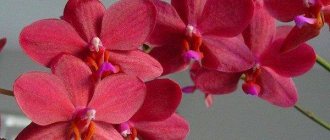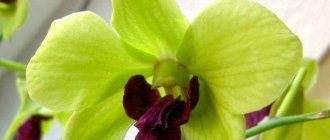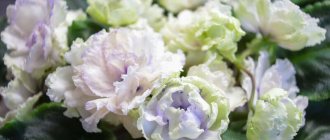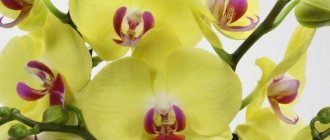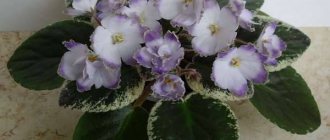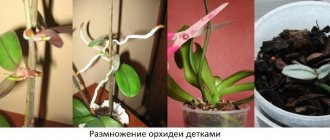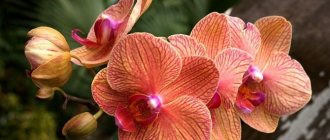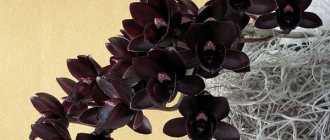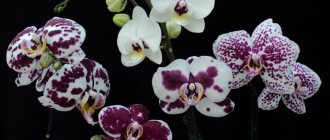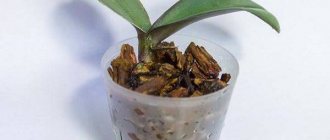Orchid is an exotic, sophisticated and majestic flower of the sultry vegetation of the tropics. This plant is called the queen of all flowers. Of all the different colors of orchids, the most luxurious and royal color can be distinguished - red.
After purchasing an orchid from a flower shop, the opening buds should be immediately red. However, the real shade will be clear after six months . Very often, for the sake of sales, colors are painted with paint, because there are not enough red orchids in nature, but there are plenty of their hybrids.
After six months, such flowers turn yellow and die, because the toxic paint gradually destroys the plant. In order not to think: whether they slipped you a fake or not, you need to know several names of the most popular and beautiful red orchids.
Scarlet orchids grown at home are most often classified as phalaenopsis . They adapt most quickly to apartment conditions and delight their owners with impeccable flowering almost all year round, with good care. This exotic plant has strong bright green leaves, a long and neat peduncle with several buds.
In addition to phalaenopsis, there are other types of red orchids - vandas, cymbidiums, cattleyas and others, but only phalaenopsis has such a rich scarlet hue. Let's look at the most common types.
Landing rules
Priming
In nature, the flower grows on trees, attached to the bark.
The substrate for a home beauty should be similar to natural conditions. The mixture includes: pieces of bark, coarse sand, humus, lowland peat, perlite, charcoal, drainage made of expanded clay or pebbles at the bottom (up to a third of the height of the container). Sphagnum moss is laid on the surface.
Optimal capacity
Clay pots work well for the development of red orchids. Transparent containers allow you to better control the condition of the plant.
Deadlines
The need to move a flower to new soil occurs no more than once every two years. The roots sticking out of the pot signal that it has become cramped. The correct time for this procedure is after flowering has ended.
Orchids are replanted every two years.
Phalaenopsis Blue
Phalaenopsis with blue flowers look very exotic; it is this color that gives the trunk additional unusualness. But not everyone knows that orchids with this color of flowers do not exist in nature; their DNA does not have a gene that gives this color to the petals.
Phalaenopsis with blue flowers.
Blue Phalaenopsis are obtained using staining, which is carried out using a special technology:
- watering dyeing;
- staining with the introduction of blue pigment.
The first method is more gentle on the plant, but less effective. In addition, subsequently not only the petals, but also the stem will be colored, and the duration of the color change will be short-lived. As soon as you stop watering with the blue substance, the colored flower will quickly return to its original state. The second type of dyeing is very dangerous, but if you decide to go with it, try to choose the most gentle method of introducing the dye. The paint is introduced by injection into the peduncle, into the stem or into the root.
In most large flower shops, information that painted Phalaenopsis is hung near the shelf with flowers. Some sellers, on the contrary, try to present the painted trunk as something supernatural and sell the plant at a very inflated price. At the same time, the quality of the coloring itself leaves much to be desired.
It all started in 2011 at a tropical plant exhibition in Florida. It was there that the phalaenopsis orchid with blue flowers was put on public display for the first time. Manufacturers did not hide the fact that their standard was painted. They patented the process technology and still keep it a closely guarded secret. Three months later, a tropical beauty with a similar color was presented in Europe. It was shown by Dutch breeders; the fruit of their development is also a colored standard.
However, as a result of crossing, it was possible to obtain varieties with blue shades of petals (see above, blue hybrids).
The world's first blue phalaenopsis, Aphrodite blue, obtained through genetic engineering.
The only type of blue orchid that can be called natural is Phalaenopsis Aphrodite, bred in Japan. This species is the fruit of many years of experiments by a group of genetic engineers and breeders at Chiba University.
The plant with white flowers was given the “blue” gene from the flower of Commelina (or blue-eye), which is native to Asia. The blue orchid Phalaenopsis Aphrodite is very prolific - it can produce up to thirty small flowers with a diameter of five cm in one flowering. But, unfortunately, at the moment Phalaenopsis Aphrodite is not available to ordinary plant growers.
How to choose an orchid
You can find an orchid in flower shops at any time of the year. However, experienced gardeners warn that you should not buy a heat-loving plant if the outside temperature does not exceed 0°C. During transportation, the tropical plant may freeze and die. In addition, it is not recommended to purchase a flowering plant: it spends a large amount of energy on flowering, and is greatly depleted. It is possible that a blooming red orchid that has stood for a long time in a store window will die after moving.
When purchasing, it is important to pay attention to the condition of the plant’s root system. The first thing to do is check how tightly the plant “sits” in the pot. To do this, you need to carefully grasp the base of the orchid stem and move it slightly. If the flower is unstable, it can be assumed that it was recently replanted. You should not purchase such a plant - it has not yet taken root. The roots of the orchid should be dense and elastic. The fact that the plant is healthy is indicated by the light green tint of the roots. Brown or dark gray roots indicate fungal diseases, excessive moisture, and mechanical damage to the root system.
The leaves are also an indicator of the health of red orchids. In healthy plants they are dense, elastic, and green. You should not purchase a specimen whose leaves have stains, mechanical damage, or dents.
General rules of care
Recommendations for caring for an orchid at home:
- Lighting. Providing a large amount of diffused light, without direct exposure to sunlight. The ideal location is windows on the east side.
- Temperature. The most comfortable temperature range is 15-25C.
- Watering. Alternating two methods of watering - through a tray and conventional, with a watering can. The use of periodic spraying of foliage from a sprayer.
- Air humidity. Maintaining indoor climate humidity at 30-50%. Elimination of dust and excessive drafts.
- Feeding. Timely fertilization with specialized compounds containing nitrogen, potassium and phosphorus, 3-4 times a month after moistening the substrate. As well as the use of stimulants and adaptogens to improve plant growth. Folk remedies and universal fertilizers for indoor flowers are not suitable for feeding orchids.
- Transfer. This procedure is carried out:
- after the purchase;
regularly every two to three years, as it grows and develops;
- urgently in case of plant disease;
- if necessary, transplanting a young shoot.
- Diseases. If signs of flower damage by pests or diseases are detected, treat with special fungicidal or insecticidal preparations according to the instructions attached to them.
It is best to replant orchids in the spring and summer.
Features of home care
Flower growers often wonder how to care for phalaenopsis at home? Despite the increased demands of this flower, caring for it is not at all difficult. If you follow the recommendations of gardeners, the plant will delight you with its extraordinary beauty all year round.
Temperature
The temperature regime for an orchid is very important. Flowering depends on it. If in winter the plant stays in a room where the temperature is about 25 ° C, the orchid will not bloom.
The optimal temperature is considered to be no lower than 16 °C and no higher than 18 °C in winter, and in summer it should fluctuate between 20-25 °C.
Note! To stimulate flowering, you need to provide the plant with a difference between day and night temperatures of 3-5°
Lighting
Phytolamp for orchids
The flower also needs additional lighting in the autumn-winter period. The duration of daylight at this time should be at least 12 hours.
Phalaenopsis is watered in one of two ways:
- using a watering can. It is better to water the orchid when it blooms, since during this period it is advisable not to change the location of the plant, otherwise it will drop its flowers;
- using immersion. This method is used when the orchid does not bloom. The pot with the plant is immersed for 1 or 2 minutes. into a container of water. When air bubbles stop releasing, the pot is pulled out. The water must drain completely, and only then the orchid is returned to its place.
Important! Do not allow the soil and roots to always be wet. Once a week they must dry out, otherwise the substrate will begin to collapse and the roots will rot.
Water for irrigation is left to settle for 24 hours. It should be no lower than room temperature, but preferably 4° higher. If there is a lot of lime in the water, it needs to be neutralized:
- water is poured into a plastic bottle and frozen. After this, cut off the bottom of the bottle and drain the water in parts;
- You need to add oxalic acid to the water. For 1 liter, use acids on the tip of a knife. After this, the solution is left to stand for 2 or 4 days. When the settled salt is visible at the bottom, you can start watering.
Spraying
Note! When phalaenopsis blooms, it must be sprayed very carefully so that water does not get on the petals. Otherwise, brown spots will appear on them, and the flowers will quickly fall off.
Humidity
In natural tropical conditions where orchids grow, air humidity reaches 90%, but in an apartment it will be enough to maintain it at 40-60%. This is especially important in winter, when batteries dry out the air by up to 20%. To maintain humidity at the proper level, you must use any of the following methods:
To maintain humidity at the proper level, you must use any of the following methods:
- hang wet towels on the radiators;
- purchase an air humidifier;
- Place an aquarium with fish next to the flower;
- spray the plant regularly;
- place the pot in a tray with expanded clay or moss.
Plants in a tray
The basis of the substrate for the phalaenopsis orchid is the bark of the small and medium fraction. If the air in the room is dry, then pieces of sphagnum moss should be added to the bark.
Basically, medium-fraction bark is laid out on the bottom, and fine-grained bark is poured closer to the surface.
Important! Before planting the orchid, the bark needs to be soaked in water for a day. After this, it is drained and washed again in clean water, and then mixed with pieces of sphagnum moss and a flower is planted
Feeding
Phalaenopsis does not have a clearly defined dormant period, but the care rules for this plant in winter should be changed.
As already mentioned, the orchid needs to be provided with additional lighting so that the daylight hours are at least 12 hours. The temperature in the room must be kept at least 16 °C. Watering is required moderately, only after the soil has completely dried.
Trimming
It is not necessary to trim the peduncle after flowering. The plant itself decides whether it will continue to throw out buds or not. If the peduncle has completely dried out, then it can be cut off.
Popular varieties
There are many varieties of this crop; they differ in petal color and shape.
Phalaenopsis lovely
Lat. Phalaenopsis amabilis.
Epiphytic species with a short stem, fleshy, shiny leaves of a dark green tone. 4-5 leaf blades are formed on one plant.
The flowers consist of white petals with a slight lilac tint. The lip is red-yellow. Diameter - from 6 to 10 cm. Long-lasting flowering - begins in May and ends in October.
Phalaenopsis prefers high humidity, moderate watering and bright lighting.
Apple Blossom
A medium-sized plant with beautiful snow-white inflorescences up to 8 cm in diameter. The lip is yellowish with purple stripes inside. The leaves are dark green, leathery, elongated - length 15 cm, width 5-6 cm.
Schiller
The natural habitat of the epiphytic flower is the island of Luzon (Philippine archipelago). The stem is short with 3-6 leaves, thick and well-developed roots.
The leaf blade is oval, dense, dark green with a silvery coating. Length 50 cm, width 10-12 cm.
The peduncles are long - they can grow up to 1 m in height and form a large number of inflorescences. The petals are white with a slight pink tint. The lip comes in different shades.
Royal
The royal orchid will not go unnoticed
It is distinguished by large inflorescences and long flowering. The flower remains decorative for two months longer than other varieties.
It also stands out in terms of height - the height at home is about 1 m. The buds of the royal orchid consist of snow-white petals covered with pink spots, tiger shades, and contrasting inclusions. The diameter is from 12 to 15 cm, in some specimens it reaches 20 cm.
Wanda
This plant has a massive root system, a stem up to 1 m high. Long flower arrows develop from the axils of the leaves. Each produces 15 inflorescences with snow-white petals speckled in different shades.
The leaves are dense, elongated, emerald or bluish-green in color.
Sandera
Lat. Sanderiana.
An epiphytic plant, resembling the Schiller orchid in appearance.
The root system is well developed with long and smooth roots. One flower produces 1-3 leaves, 15-30 cm long, 7-10 cm wide, dark green in color, with an ash-gray ornament on the surface.
Flower shoots up to 80 cm in height, forming 50 inflorescences.
Flowering is long lasting - lasts several months. The decorative effect lasts for 3-4 weeks. The color of the petals is white with a slight pink tint, the lip is yellow-red.
Heron
The flower received this name due to its inflorescences, which look like a heron or a swan in flight. This species, originally from Japan, is a deciduous species that sheds leaves and even shoots during the dormant period.
The variety can be distinguished not only by its unusual flowers, but also by small peduncles, oblong, dark green leaves that lightly cover the stems.
Reproduction methods
There are two methods of propagation - seed and using sprouts.
The first method is ineffective, because it is very difficult to create a special environment for sowing at home. The seeds are small, like dust, and it is difficult to take root if the germination technique is disrupted. It is usually practiced in laboratory conditions.
The second option is more effective and justified.
Flowers over 3 years old produce babies (take those that grow in the upper part of the shoot, as the lower ones have poor survival rate). They are separated together with the stem so that the bottom and top are 2-3 cm long.
The plant does not reproduce easily
The cut areas are sprinkled with charcoal. Then they are immersed in one of the root growth stimulators for half an hour.
- The sprouts are planted in a nutrient substrate of steamed crushed pine bark, charcoal and sphagnum moss. As a planting container, you can use 100 ml plastic cups with holes in the bottom.
- The seedlings are irrigated with a spray bottle and placed in a warm and well-lit place.
For quick rooting, they can be covered with a transparent film. As soon as they begin to form new buds, the shelter is removed.
After 3-4 roots appear, they are transplanted into a plastic or ceramic pot slightly larger than the size of the roots.
Correct fit
Priming
Vanda doesn't need soil. Vanda lovers say they are in special glass vases. Or a flowerpot;
Vandas can be grown without any soil at all.
- But others grow it, like many orchids: Medium pieces of coniferous bark;
- Pieces of charcoal;
- Peat;
- Coir;
- Pieces of foam. Pine cones;
- Drainage 2-3 cm from expanded clay, fine gravel;
- You can also use perlite. To maintain humidity.
Optimal capacity
- For Cattleya. Simple pot. Clay is better. Without any glazes;
- Vanda - pots with holes on the sides. Hanging baskets, aquariums. And glass vases.
- Transparent containers with numerous holes are more suitable for phalaenopsis. Not just from below. And also with the sides.
Technology
- Prepare the plant for planting (or transplanting). Divide it if necessary. Treat the cuts with crushed charcoal. Remove diseased and dried roots and leaves;
- Plants with 3-4 pseudobulbs are suitable for replanting. And children with roots of at least 4-5 cm;
- Prepare the soil, container, drainage in advance;
- Place the plant in the container. Fill with substrate;
- Hold off on watering.
Deadlines
- Every 2-3 years, orchids are replanted;
- Only the condition of the plant and soil can tell you the need for this procedure: After purchasing in a store;
- The plant is cramped in the old container;
- The density and strong oxidation of the soil only suggests the need for replanting;
- Identifying pests or diseases.
Pests and diseases
- Spider mites are the most common “pest” for burgundy phalaenopsis; they multiply very quickly and practically eat the plant. For any mites and other pests, flower growers recommend immediately spraying the orchid with a special solution or soaking it with the roots in an insecticide for 15 minutes and sending it to quarantine (at least for a month).
- Various rots , especially in summer, affect the roots and leaves of a weakened orchid; the flower can rot and die. If you see rotting of the root, immediately save the flower: replant it, carefully cut out all the rotten roots with a knife. It is better to disinfect the “wounds”, sprinkle them with cinnamon and lubricate them with foundation.
- Fungus in the bark, on the leaves . An urgent transplant is required here. The contaminated substrate should be changed. Disinfect the pot, treat the window sill or the place where the pots stand. Use a spray of phytosporin solution or any other antifungal drug. The dosage of the medicine must be very moderate, since the medicine, if taken incorrectly, has a negative effect on the root system as a whole. To disinfect the roots, you can treat them with 3% hydrogen peroxide.
- Yellowing of leaves - the orchid has “overheated” in the sun. Move it to darker areas. But the light should still come in smoothly and softly.
- Dropping buds and leaves - not enough light. If it is autumn or winter, use additional lamps to extend the daylight hours for your flowers.
WARNING : Beware of drafts. Do not place pots over radiators.
Do you dream of decorating your home with orchids of various colors? We advise you to study photos and rules for caring for plants with black, lilac, gold, white, purple, green, orange, pink and blue flowers.
Intergeneric hybrids
Doritaenopsis Liu's Sakura 'KF#2'
Thus, before the latest changes in the taxonomy of orchids, Phalaenopsis pulcherrima was called Doritis pulcherrima, and all hybrids between it and representatives of the genus Phalaenopsis were given the name Doritaenopsis. Thus, many hybrid phalaenopsis known to domestic orchid lovers are dorithenopsis. "Doritaenopsis Liu's Sakura 'KF#2'" caused a particular stir. It is a compact plant with dark, dense leaves and a slight purple tint. Its petals are a delicate pearlescent pink shade and have a very interesting shape, which makes the inflorescence look surprisingly elegant.
Blue hybrids
Such specimens appeared in culture recently, after the discovery in nature of the blue forms of Phalaenopsis violacea coerulea, Phalaenopsis equestris cyanochilus and Doritis pulcherrima coerulea. Blue coloring is not typical for orchids. Getting a Phalaenopsis orchid with soft blue flowers has always been the dream of breeders. When we found natural blue Phalaenopsis with small flowers, joy knew no bounds.
Doritaenopsis Siam Treasure “Blue” was obtained by crossing Phalaenopsis Pleasant and Doritanopsis Most Beautiful
Selection work has not greatly improved the appearance of blue Phalaenopsis: their flower stalks produce almost white flowers with a slight gray-blue tint or medium-sized purple or pink-blue flowers. The following varieties of blue hybrids have become available to domestic collectors: Doritaenopsis Siam Treasure “Blue”, Doritaenopsis Kenneth Schubert “Blue Angel”, Doritaenopsis Purple Martin “KS”, Doritaenopsis Peter “Blue Sky”.
Phalaenopsis pelorica
Sometimes, as a result of a plant mutation, not only the leaves, but also the flowers suffer. They have an incorrect corolla structure, resulting in the formation of abnormal, almost actinomorphic “butterflies”. For example, some flowers have petals or sepals that have the shape and color of lips. For others, the lip looks like petals. Such specimens are called pelorics. They look very unusual. In nature, Phalaenopsis pelorics appear as a result of exposure to certain environmental factors. A similar phenomenon is typical for varieties such as Phalaenopsis Stuartiana, Phalaenopsis pulcherrima or Phalaenopsis Schillehana.
In floriculture in general, unusual deviations from shape arouse increased interest. Likewise, pelorics are popular among Phalaenopsis. An example is the following hybrids: Phalaenopsis Bubble Gum “Shwartz”, Phalaenopsis Terradyne “Muligan”, Phalaenopsis World Class “Big Foot”.
Phalaenopsis Bubble Gum "Schwartz"
Please note that Phalaenopsis pelorics obtained by cloning are on sale. This means that during the next flowering, in such plants, peloria may appear in a completely different form.
Many lovers of not only orchids, but also other exotics began to search for and collect such “miracles”.
In addition to the Phalaenopsis varieties described above, the following hybrids are popular in Russia:
Legato (Phalaenopsis Legato) has flowers painted in amazing colors of gold, pink, lilac with pearlescent iridescence
Phalaenopsis Cleopatra blooms for a long time with pearly yellow flowers with lilac and pink specks
Singolo (Phalaenopsis singolo) has one flower on a peduncle - this is its uniqueness
Phalaenopsis Sakura (Phalaenopsis Sakura) is one of the most airy and delicate varieties of feminine orchids with white flowers iridescent in lilac shades
Blue and cyan orchid
Warning: blue and sky blue orchids do not exist in nature!
What can be seen at exhibitions is nothing more than a PR stunt of marketers who, in alliance with biochemists, came up with a paint that does not injure plants, which is injected into the common peduncle. Another way of coloring is by watering.
Sellers and breeders from Holland, where such orchids first appeared, claim that their coloring technology does not harm the flowers. However, there is no point in buying these specimens - over time, the effect of the dye ends and the flower petals become discolored. True, in 2013, a hybrid called “Aphrodite” was bred, which, according to the breeders, has a real blue petal color.
We can talk about the naturalness of color only in the case of white flowers that have blue and blue veins.
Distinctive features
Today you can find a large number of red orchids. There are about 70 varieties in nature.
Features of these orchids:
- long flowering under favorable conditions;
- red flowers;
- under natural conditions, these varieties are extremely rare;
- practically unlimited period of life of peduncles;
- the peduncles are few-flowered, but due to their large number it seems that the flowering is abundant.
Reference
If you want to breed a red phalaenopsis orchid, you need to pay attention to the variety. Some sellers offer Vanda, Cattleya or Cymbidium varieties, which are considered a good option for beginners
They are also red, but are not related to phalaenopsis.
Red orchids: photo and description
Red orchid flowers go perfectly with any design, refreshing it and adding a bright note. This unusual representative of tropical flora is distinguished by its sophistication and fragility. Indoor plants have thin, elongated stems and dense, fleshy leaves. Inflorescences of red orchids can have several flowers or one. The quantity depends on the care and conditions of detention.
Territory of distribution of species in nature
Large-flowered orchids, such as Cattleyas, Phalaenopsis, Paphiopedilums, Cymbidiums, were brought to Europe from:
- Tropics;
- And subtropics;
- Many are from mountainous regions.
Most species are epiphytes, some are lithophytes; there are species and entire genera growing on the soil. Orchids have colonized all continents of the Earth, with the exception of Antarctica. The number of genera, species and hybrids is so large that they occupy a tenth of the planet’s flora.
Orchids feel best in the subtropics:
- Southeast and South Asia;
- Northern Australia;
- Brazil.
Here are the optimal temperatures (and their seasonal/daily differences), humidity, day length by season, and illumination. Second distribution zone:
- Line connecting South and Central America;
- And North Africa.
At times, 100 percent humidity and warmth are beneficial factors for orchids.
The third, most severe territory for the family is the steppes and plateaus of Eurasia. Small and medium-sized species grow here. There is even an orchid with one large flower.
Yellow orchid
Varieties of phalaenopsis bred through selection. They require long daylight hours, so the best location for such orchids is in eastern or western windows, with the possibility of diffuse artificial lighting.
Breeding varieties, as a rule, are very unpretentious, and the main thing in their maintenance is the once and for all established regime of light, humidity and fertilizing. Since most of the yellow orchid species are epiphytes, they have enough support from neighboring flowers, in the vicinity of which they will take moisture and nutrients from irrigation water with their aerial roots.
Therefore, you need to take care in advance:
- the presence of such neighboring plants or any support for them in the form of driftwood, wood structures without treatment or impregnation with chemicals;
- the presence of fertilizers in the water with which these phalaenopsis are sprayed.
What kind of flowers are these?
Definition
The lilac orchid is known as "violation". Scientific name: Phalaenopsis violation.
The main feature of the species is its lilac flowers, with shade variations from light lilac to deep purple; it is also called the purple orchid. Flowers are entirely one color or with:
- interspersed;
- dots;
- stripes;
- spots.
Description of appearance
Unlike other types of orchids, a small number of flowers appear on lilac. The maximum width of the flower is 6 cm. The petals are oblong, oval in shape, their surface is smooth, waxy. Lilac orchid flowers have a pleasant, pronounced aroma - the smell is similar to:
- freesia;
- bergamot;
- the smell of water lilies.
The plant blooms all year round, with peak flowering from spring to autumn.
The leaves of the orchid are elongated, elliptical in shape, large, fleshy. In an adult plant, the length of the leaves can reach 30 cm and the width - 15 cm.
Are there plants of this color and what is their feature?
Definition
“Red orchid” is usually called a genus of orchids with rich bright red petals - phalaenopsis; in addition to phalaenopsis, red buds can be found in such genera of orchids as vandas, ascocendes, aerides, cymbidiums, cattleyas, but this color is less common in them than in phalaenopsis .
Description of appearance
Phalaenopsis have fragile short stems, evergreen leaves with a marbled pattern, and flower stalks between the leaves. There can be up to 50 flowers on one peduncle, the flowers are mainly in the shape of butterflies. Aroma of varying degrees of intensity.
Varieties: description and photo
Equestris
A variety of miniature orchid. The stem is up to 18 cm. The peduncle is about 30 cm long and produces approximately 15 buds. The diameter of the flower is up to 3 cm. The petals are round in shape, narrowed at the base, the common colors are pale lilac and lilac-pink.
The peculiarity of equestris is its growing peduncle; during flowering it lengthens, and new buds form on it, while the old ones fall off. It blooms most often in spring and autumn, but can bloom without a dormant period.
Phalaenopsis Luddemann
On one peduncle of Luddemannna, up to 7 flowers are formed, with a diameter of about 6 cm. The flowers have variegated pink-violet petals, and the color is more saturated at the center of the peduncle.
With quality care it can bloom continuously all year round. Loves high temperature and humidity.
Cleopatra
The height of the plant is average, 60-70 cm. The leaves are rich green, usually from 3 to 7 pieces, 10-30 cm long. On the peduncle there are often 10 flowers, round in shape, with a diameter of 5 to 8 cm.
The main background of the petals is white with dots of lilac, pinkish and purple colors that form an unusual pattern. Flowers last up to 6 months. Blooms most often from January to June.
Here you can see what the Cleopatra orchid looks like:
Amsterdam Jordan
The peculiarity of the variety is that the white petals are covered with a scattering of dots of different shades of pink and lilac, in the form of rays diverging from the center. The peduncle of an orchid up to 60 cm high can branch, forming a lush brush.
Deborah
This orchid has fleshy roots, 3-7 cm in diameter. Its leaves are smooth, oval in shape. Usually it has 2-3 peduncles 55-65 cm high. The diameter of the flowers is 7-8 cm. The main colors are red and purple. The edges of the petals are edged with white.
The opening of flowers is sequential, so flowering is long - from 6 to 8 weeks. It can bloom 2 times a year.
In this video you can see what the Deborah orchid looks like:
Dendrobium phalaenopsis
In appearance, dendrobium resembles phalaenopsis, hence the name orchid. Up to 20 flowers with a diameter of 3-5 cm are formed on a peduncle. Moreover, in some plants several peduncles can form from the top at once. Flowering begins with the arrival of spring and lasts 1-3 months. Various colors are possible, including dark purple.
Dendrobium Nobile
The average height of the plant can reach 50-60 cm. The number of leaves increases every year by 1-3 pieces. The peduncles are short; several dozen flowers are formed on them. The color is lilac and shades of lilac of varying degrees of brightness. Flower diameter up to 9 cm.
Varieties
After reading the descriptions of popular types, you will choose the most suitable variety to decorate your home or apartment.
Multiflora
One plant produces 3-8 green thin peduncles.
This variety attracts with the splendor and abundance of flowers - they are densely planted, small in size - 4-5 cm in diameter. The petals are yellowish, the lip is purple.
The leaves are dense, emerald green, oval with a pointed tip, collected in a compact rosette.
Stuartiana Nobilis
This plant is difficult to confuse with other varieties - the inflorescences consist of yellow petals. Tiger lip - the main tone is yellow with small brown or red splashes.
Height is about 50 cm. During the flowering phase, 60-65 flowers open simultaneously, which create a beautiful and lush head.
The peduncle is cylindrical, green, and grows over time. The leaves are emerald, leathery, with a glossy surface.
Yellow mini orchid
Compact miniature variety - maximum height 20 cm.
Flowering is long - about 6 months. The plant takes turns producing new arrows with fresh bright yellow flowers, so during this period it looks colorful and impressive.
Golden Jaguar
The flowers consist of long petals, pointed at the tip.
In most varieties, the yellow color scheme is complemented by pink, green, red and yellow shades in the form of specks, streaks or stripes.
Amadeus
There are many varieties of orchids
Amadeus is an orchid with bright yellow flowers, with symmetrically arranged sepals and petals. They have the correct shape.
The size of the inflorescences is 7-8 cm. The petals are dense, pink or purple at the base.
The lip is yellowish and contains elements of burgundy or black-brown color.
Oncidium
Another popular species that comes in many hybrid forms with yellow flowers.
The main difference between Oncidum is a long, thin peduncle; a large number of small yellow flowers (diameter 3-4 cm) with shades of pink, red, green, purple and white bloom at the tip.
The color of the petals varies - from pale yellow to rich lemon color.
Spraying and watering
Despite the fact that this orchid hybrid is great for living at home, it would be better to try to bring them closer to natural ones. This can be done by spraying and watering. To do this, simply give the plant enough moisture. For example, in the winter season you should spray about three times a day.
You can add a warm shower to this. To do this, take a pot with a flower and put it in the bathroom. Next, using a spray shower head, begin watering the plant until the soil is saturated. Then you can leave the orchid in the bathroom for twenty minutes to drain off excess moisture.
Transfer rules
In order not to damage the roots of burgundy phalaenopsis, it is replanted by transshipment. To do this, place the pot in a bucket of water for half an hour to properly soak the soil. When the soil softens, carefully remove the flower from the container and wash the entire root system with warm water. Rotting and old roots are cut off, and the cut areas are disinfected with charcoal.
Before planting the plant in a new pot, you need to make sure that all the roots are dry. The soil must be nutritious and disinfected. The flower is slightly moistened in a new place. If you properly care for your orchid, it will quickly adapt to its growing conditions.
Existence in nature
- Orchids themselves, like flowering plants, leave few people indifferent. Delight and admiration. And here it is also black. The color of mystery, mystery and uniqueness;
- They talk a lot about them. They show videos and publish photos with love and trepidation. And with noticeable pride of the happy owners of such;
- Are there orchids with black flowers in nature? If they exist, where can I buy them? And how to care for it? The discussions and statements of representatives of opposing opinions are interesting: Those who deny this fact give serious arguments from scientists: There are no purely black genes in nature. This is convincingly proven by scientists. There are no such pigments - says science. So there cannot be exclusively black flowers;
- And the numerous orchids with black flowers available for sale are a commercial brand. Take a close look at the flowers. You will see, at best, dark shades of burgundy and blue. There's a lot of money floating around.
- In addition to the stories mentioned, they will tell you many more to confirm the existence of such black flowers;
- Cattleya;
Black cymbidium.
And don’t forget about the art of photography and its possibilities. Lighting and background can change a lot.
Red phalaenopsis orchids
Red flowers are found in different types of orchids. In everyday life, you can most often find phalaenopsis, since compared to other species, they most easily adapt to home conditions.
This genus is represented by more than 70 species of epiphytic plants that are monopodial.
The number of evergreen leaves is approximately 4 to 6, slowly aging, turning yellow and dying. They are then replaced by growing young leaves, reaching a length of up to 50 cm and a width of 5-10 cm.
On window sills, flower growers most often display Phalaenopsis hybrids with a pleasant Ph. amabilis, Phalaenopsis Schiller Ph. schileriana and Phalaenopsis Stewart Ph. stuartia.
Plant collectors, in turn, have a large assortment of species and hybrids.
Advice! The plant is unpretentious. If the conditions are close to natural, then phalaenopsis can delight with its flowering twice a year for 4-5 months. There have been cases when red phalaenopsis delighted with its flowering for as long as 8 months.
Among the orchids with red flowers are the following varieties:
- Vanda is a representative of orchids, not related to phalaenopsis;
- Cattleya is one of the types of orchids with bright flowers (also not phalaenopsis);
- Cymbidium - there are species with red flowers (And this is not phalaenopsis);
- Red Buddha;
- Red Dragon;
- Red Jaguar;
- Harlequin;
- Kimono.
Red Buddha (Buddha's Treasure).
Vanda ampullacea.
Cymbidium Clarisse Austin 'Best Pink'.
Phalaenopsis hybrid Kimono.
Phalaenopsis with red flowers look very luxurious . Up to 40-50 flowers with petals similar to butterfly wings can bloom simultaneously on a flexible stem. This wonderful living plant will become an unusual and bright accent in your home and give it a sweet aroma.
Possible colors
In nature, there are 30 thousand colors of orchids. They come in one-color, two-color, with patterns, all the colors of the rainbow. However, scientists do not stop at this and continue to develop new varieties of phalaenopsis.
In room conditions
At home, all colors of orchids are found. Plants are:
- white;
- light pink;
- purple;
- blue;
- black;
- red;
- radiant;
- pistachio;
- Crayola;
- raspberry;
- burgundy;
- orange.
Hybrids and natural varieties of phalaenopsis take root in indoor conditions.
In the natural environment
Thanks to natural pollination, orchid flowers can be unpredictable in natural conditions. Of course, you won’t be able to find a black or bright blue flower. This is the work of scientists. In nature there are the following shades:
- white;
- pink;
- purple;
- yellow;
- orange;
- light pink;
- peach;
- light purple;
- pistachio
After spontaneous crossing, two-colored petals with a pattern are obtained. Such phalaenopsis are more often found in the wild.
Artificially bred varieties
The variety of orchids is enormous. Below are the most unusual and beautiful hybrid species:
- Wanda Rothschld;
- Cymbidium swordifolium;
- Cattleya Ekland;
- Miltonia flava;
- Phalaenopsis Sander;
- Dendrobium Mix;
- Royal Blue;
- Blue Mystick;
- Cymbidium Black Ruby;
- Phalaenopsis Black Butterfly.
All these varieties have unusual shades that are not found in natural conditions. Blue and black colors do not exist because the plant lacks the pigment to produce such blooms.
Modern scientists have been able to develop such varieties, but after the first flowering the flowers lose their unusual color and become a different color, usually white.
Breeding history
Orchids were known to the father of botany, Theophrastus - in his works he described several species of plants . Mention of them is found among the Aztecs, Mays, Chinese, Japanese and many other peoples.
Attempts at domestication and hybridization began around the 17th and 18th centuries. The first hybrid was bred by John Seden in 1875. Several more primary hybrids were created by the beginning of the 20th century. Various crosses of varieties were reproduced throughout the century. Breeders sought unusual shapes and colors.
Various hybrids are currently being developed. Difficulty in breeding is caused by the sterility of the resulting forms and the practical impossibility of fixing the desired characteristics in a generation.
Step-by-step instruction
Care
The conditions for keeping the lilac orchid must meet the following requirements:
The room temperature should be between 15 and 25C. Daylight hours are 12 hours, in the cold season the deficiency is compensated by artificial lighting
You should also protect it from direct sunlight. The room should be ventilated, but avoid drafts. Air humidity is on average 40% -60%. Watering is carried out after the substrate has completely dried. Important! Dry walls of the pot and light gray roots indicate the need for watering.
To avoid rotting of the flower, you should refrain from frequent and abundant watering, spraying, and high air humidity. Substrate composition: bark, moss, charcoal.
By feeding
Lilac orchids should be fed no more than once a month. For this purpose, nitrogen, phosphorus and potassium fertilizers are used. This promotes prolonged flowering, active budding and increased foliage growth.
Watch a video about feeding an orchid:
By transfer
The lilac orchid is replanted every 3 years. During this time, the substrate loses its beneficial properties. Also, replanting is necessary when the pot for the plant becomes small.
It is recommended to replant the flower in early spring before the period of active growth. You should not replant an orchid that has released a flower arrow, as this will slow down the growth of the peduncle and shed flower buds.
- You should carefully remove the plants from the pot, removing soil from the roots.
- Cut off dry and rotten roots.
- Remove dry leaves - cut the leaf in half and pull it in different directions, thus removing it from the stem.
- Dry the roots for 6-8 hours.
- Place the flower in a dry pot with drainage and cover with substrate.
All detailed information about orchid transplantation can be found in this video:
By reproduction
Artificial methods of propagation of orchids include the following:
- Dividing the rhizome. Usually the division occurs independently by the plant, but you can divide the rhizome manually:
- Remove the flower from the pot and clean the roots from the substrate.
- Cut the rhizome completely between the false bulbs.
- To disinfect, sprinkle the roots with charcoal.
- Plant the resulting plants in separate containers.
- Upper cuttings. This propagation method is suitable if the areas of the shoots are located at a considerable distance:
- Cut off the shoot at the height of half the cutting.
- Disinfect the cut with charcoal.
- Plant the cuttings in a separate container.
- Side shoots. The grown side shoot should be sprayed. When it forms roots:
- Separate the escape.
- Disinfect the cut.
- Plant the orchid in a separate pot.
- Seed method. This method is rarely used, since the orchid has small seeds that do not have nutritious tissue. In this case, the orchid grows from a sprout into an adult plant after about 3 years, and begins to bloom after 10 years.
A detailed description of all methods of orchid propagation in this video:
Features of cultivation
Rules of care
The main feature of care is closeness to natural conditions; orchids usually grow in the tropics.
- When watering, make sure that there is no excess moisture, the top layer of soil should have time to dry, the water for irrigation should be at room temperature, settled, it is best to do this in the morning, it is important not to get into the leaf axils.
Sometimes you can give a flower a bath by immersing the plant in water completely with its aerial roots for a while. - The plant needs a large amount of bright, diffused light all year round. It is very important that the flower is not exposed to direct sunlight; the ideal side for keeping it is west and southwest; on the north side the flowers darken. When the plant has enough light, rich light green leaves can be seen.
- The temperature for growing red orchid should be between 20°C and 27°C. If the plant is cold, the lower leaves wrinkle.
- Frequent misting will help increase air humidity.
Moving a flower is stressful; under normal conditions, you can start watering a week after purchase, and replant it only after a month.
Top dressing
The plant should be fertilized at certain periods of its life:
- in spring , when the plant is preparing to bloom;
- in summer , but only before the first bud appears;
- during flowering, root fertilizers are replaced with foliar fertilizers;
- In winter , the orchid needs rest; feeding is stopped.
With a lack of nutrition, the plant develops chlorosis, photosynthesis is disrupted, and the leaves turn yellow and fall off.
What fertilizers are suitable:
- Universal complexes for flowering plants, they need to be diluted in more water to reduce the concentration.
- Liquid fertilizer is ideal; it also needs to be diluted in a larger volume of water.
- There are special fertilizers for foliar feeding of orchids, which are available in the form of sprays.
Transfer
It is recommended to replant the plant once every 2 years, after flowering, or earlier if the plant has grown greatly, as evidenced by the tips of the roots appearing above the substrate and fallen lower leaves.
Orchids have aerial roots, so a drained substrate containing bark, pebbles, peat, pieces of coal is suitable; such a substrate imitates natural conditions.
Transplantation is carried out using the transshipment method. To keep moisture in the ground longer, you can put sphagnum moss on top. After replanting, the plant should be shaded for about a week and watering should be reduced.
Reproduction
At home, orchids are bred by vegetation. After flowering, “babies” appear. You shouldn’t separate them right away; you need to wait until several leaves and aerial roots at least 5 mm long appear, and then you can plant them in a separate substrate.
If shoots do not appear, you should pay attention to care, provide the required temperature (27-28°C during the day, 18-20°C at night) and sufficient lighting. If leaves appear, but aerial roots do not appear, you should separate the shoot and place it in water or a specially prepared nutrient substrate.
Description and photos of varieties
Red orchids are quite rare and often stores sell hybrids or even dye the flowers to increase sales, so it is important to do your research before going to the store. Among the phalaenopsis with red petals, the following varieties are distinguished:
Among the phalaenopsis with red petals, the following varieties are distinguished.
Peacock
The most famous and common variety. It is most suitable for growing at home. The petals form peacock-shaped buds, which is how the variety gets its name.
Buddha (novelty-phalaenopsis)
A distinctive feature of the variety is the long life span of the peduncle; the peduncles are short and a small number of buds bloom on each. The flowers are small in size and form inflorescences.
The Dragon
A cross between a pinto phalaenopsis. The inflorescences are small, the buds are variegated, the plant reaches a height of 60 cm. The variety is well adapted to indoor conditions.
Jaguar
Phalaenopsis-giant hybrid. The plant reaches 120 cm in length, the buds are large, the color is variegated, the core of the bud is light. The variety is very whimsical and extremely sensitive to unfavorable care, so it is rarely found among gardeners.
Appearance
Familiar, tightly cultivated plants are generally represented by perennial flowering herbs. The flower is the main object of attention of landscape designers, flower growers and breeders.
One of the notable features of the orchid is the presence of aerial roots . They absorb moisture from the air, participate, along with leaves, in the process of photosynthesis and help strengthen the plant in the substrate.
Attention : The leaves of orchids are simple, alternate. The green flowering stem is erect, the flowers are arranged on it in inflorescences on short stalks. The flowers themselves come in various shapes, colors and sizes. Red orchids belong mainly to the genus Phalaenopsis and Cambria.
Rules of care
In order for these amazing representatives of the world of exotic flora to delight with their abundant and almost continuous flowering, they need to be provided with complete and comprehensive care. Among the mandatory conditions that it provides for are:
- sufficient illumination of plants;
- maintaining optimal air and substrate humidity;
- stable temperature conditions;
- compliance with the feeding regime.
Illumination
Insufficient light is one of the main reasons why phalaenopsis does not bloom. Being tropical plants, orchids require sufficient light to form flower ovaries. If the daylight hours are less than 12 hours, phalaenopsis will not be able to form viable buds. For this reason, in seasons with short daylight hours, gardeners recommend lighting plants with a special lamp.
The best conditions for these exotics are provided by dim, diffused, but not bright light. Such illumination can be achieved by covering the window glass with a special shading film.
Humidity
All phalaenopsis are extremely sensitive to moisture deficiency, which must be present both in the air and in the substrate. Regular spraying of exotic plants will help maintain the necessary air humidity. Some experienced gardeners use electric humidifiers for this purpose, and even ordinary bowls of water placed near the plants. To prevent the orchids from drying out and wilting, you should control the humidity of the substrate in the pot. It should be moderately moist, but not wet
When watering, it is important not to allow excess moisture: the roots of the plant should not be flooded, otherwise this may lead to their rotting. Signs that a plant needs watering:
- wilting and yellowing of leaves;
- drying of leaves around the edges;
- change in color of roots to gray-green.
It is necessary to water orchids only with soft warm water. It is optimal if it is rain or filtered water after settling. Watering with cold, hard water is the strongest stress factor for plants and can cause their death. In order for orchids to feel good, you should adhere to a certain watering regime. In hot weather, it is enough to water them 2-3 times a week, in cold months - 1-2 times a week.
Temperature
Capricious exotic beauties do not tolerate temperature changes well. Flower growers remind that for normal well-being of plants, the room temperature should be maintained within 18–20°, avoiding sudden changes. In the cool season, as well as during the period when plants enter the dormant phase, the room temperature may be slightly lower than the specified norm
It is important not to let the temperature drop below 10°
Feeding mode
By following the feeding regime, you can stimulate massive and long-lasting flowering of orchids. For fertilizing, water-soluble complex fertilizers intended specifically for these exotic plants are usually used. When planning to feed orchids, you should remember that this procedure cannot be carried out on sick, recently transplanted or newly purchased plants. It is not allowed to apply fertilizers to dry substrate: this can cause severe burns to the delicate roots.
You can find out how to distinguish the Pink Dragon and Manhattan orchids below.
Features of care
It is worth taking a closer look at how to properly care for an orchid. This determines how quickly the flower will grow and whether it can bloom for a long time. If conditions are not optimal, the orchid does not produce flower stalks at all.
Temperature and lighting
Basic temperature requirements:
- during the day the temperature is +22…+27 degrees;
- at night it should be about +18 degrees;
- There should not be differences of more than 5 degrees.
Important! Orchid is demanding on lighting. She needs quite a lot of sunlight, so the plant is usually placed on the windowsill
However, the light must be diffused. When exposed to direct sunlight, burns appear on the leaves. It is necessary to take these nuances into account when choosing a place for culture.
Watering and air humidity
The plant prefers high humidity. The optimal value is 80–90%. To do this, you need to install a humidifier or place a container of water next to the crop. At the same time, phalaenopsis requires proper watering - if there are errors, it will die.
Basic Rules:
- Without flowers, you need to water once every 7-10 days.
- If it's hot outside, watering is done every 2-4 days.
- You can determine whether it is necessary to water by looking at the top layer of soil: if it is dry, it should be moistened.
- Spraying is required periodically, but water should not get into the rosettes of leaves, as this can cause rotting.
Important! When moisture gets into the rosettes of the leaves, it must be removed with a cotton swab. Watering should be shallow
Stagnation of water in the pot is prohibited, as the roots begin to rot quickly. The liquid must be poured out of the pan.
Top dressing
It is necessary to apply fertilizers correctly for the crop to thrive. They do this:
- during a period of active growth;
- during the appearance of buds;
- when flowering, so that it is more abundant.
Important! You should not fertilize the flower immediately after purchase, as it needs some time to adapt to new conditions. In this case, it is worth using aqueous solutions, not tablets.
It is recommended to fertilize every 20 days to keep the crop stronger.
Characteristic
White color is associated with innocence, purity and limitlessness - the same meaning is given to the white orchid. Some believe that it has magic, cleanses the house of all negativity, and brings prosperity and good luck.
In their natural environment, the plants are quite large - up to 100 cm in length. In apartment conditions, miniature species are grown, reaching 20-30 cm in height.
The main features include:
- butterfly-shaped inflorescences;
- the root system is massive, well developed;
- leaves are ligulate, emerald green;
- blooms three times a year;
- a flower arrow forms at the base of the lowest leaf;
- the plant does not form pseudobulbs.
